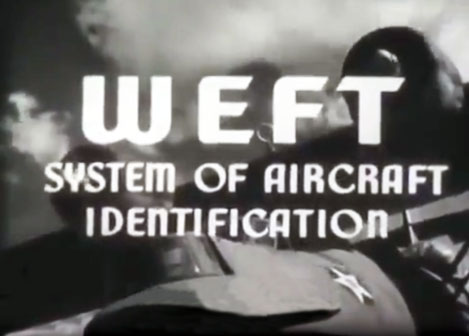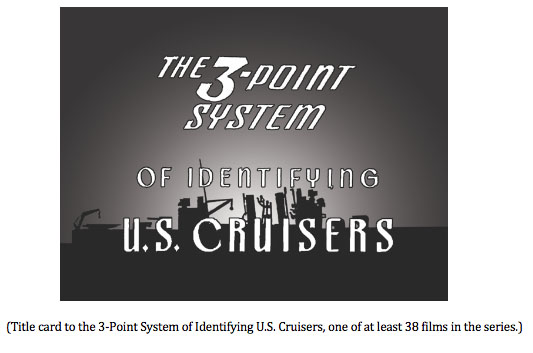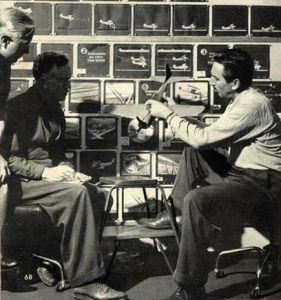
On December 8, 1941, the day after the bombing of Pearl Harbor Naval Base on the island of Oahu, Hawaii, Walt Disney received a call from a Naval Officer in Washington, DC. The call from Navy Lieutenant Cottle was to offer Walt Disney Productions a contract for approximately twenty training films on ship and aircraft identification. The actual number of films changed over time as the requirements shifted. (1) This contract was a direct result of correspondence between the studio and a Lieutenant Hutchinson in November 1941 outlining the need for these training films and the specifications of how they would be created. These first Military training films were the WEFT, an acronym for Wings, Engine, Fuselage and Tail, and the 3-Point Identification System for recognizing and distinguishing between friendly and enemy aircraft and Navy ships.
Hutchinson had corresponded with the Disney Studio on the Navy’s need for this series of films that could train military personnel in identifying aircraft and naval ships. That correspondence dictated the requirements needed by the Navy and the response detailed what the studio could provide to satisfy the need. Walt had determined that the films didn’t need to be in color and that black and white 35MM film would be the best approach for the series of films. (2) Although, it would have been less expensive to use 16MM, using the larger format 35MM film was better suited for the planned double-exposure special effects that were to be used in illustrating clearly the various educational points. It was rudimentary animation but it was still sophisticated in the use of camera techniques to achieve the desired goals of the films.

Once the contract was awarded, Disney had ninety days to begin delivering the first films in the series. This was an accelerated pace given that the studio was used to, in pre-war years, spending upwards of three years on an animated feature. Now the studio was producing four times as much footage than a single feature in six months and this was just for the WEFT and 3-Point Identification. It didn’t include the deluge of other films that were being ordered once the U.S. had entered the war.
In order to get production underway, a technical adviser was assigned to the studio as consultant for WEFT and 3-Point Identification. The Navy agreed to supply all the necessary models and access to bases and aircraft in order for the films to be created accurately. The studio that was used to creating entertaining and visually stunning animation for wide audiences was now grinding out bland, black and white training films that were dry and devoid of any entertainment quality. In fact, the Navy frowned upon using humor.
The plan was to initially produce one WEFT and one 3-Point Identification film simultaneously so that the look and content could be approved before production got underway for the entire series. Ub Iwerks, who had returned to the Disney Studios in 1940 to handle special optical effects, was assigned the task of writing and directing most of scripts for these films because of his fascination with aviation and model planes.(3) Iwerks was a natural choice for these films since they consisted almost entirely of special animated and optical effects.
Many of the training films from this period utilized extensive optical effects that were created with the animation camera. There was such volume of work going through the Disney camera department that the cameramen were working in shifts around the clock. The optical effects such as double-exposures, cross dissolves, ripple glass, and backlight burn-ins were developed and perfected on films like The Old Mill (1937), Snow White and the Seven Dwarfs (1937), Pinocchio (1940) and Fantasia (1940). These techniques were deployed to make static primitive artwork appear to be more visually robust and to enhance the illustrative points being covered in the training films at minimal expense. Faster and cheaper was the order of the day since these films were being made at cost and the accounting was scrutinized by the U.S. Government. Early on, the U.S. Navy had nixed any overhead and profit being added on for the studio, which frustrated Walt with the “nickel-and-diming of government bureaucrats.”(4)

The animation was assigned to Thor Putnam, Yale Gracey and Bruce Bushman(5) among others as part of Animation Unit 2A, which was the first training film unit established by Walt at the studio. Rounding out the team was Irwin Verity, assistant director on the series, and Carl Nater the production coordinator for the Military Educational Films unit. Nater was so engaged with these training films that he continued doing educational films at the studio after the war eventually being named president of Walt Disney Educational Materials Co. in 1969.
Once the films were well underway, the WEFT series of aircraft identification films, which were intended to instruct aircraft personnel on quickly identifying enemy aircraft from friendly allied planes, quickly fell out of favor with the Army and Navy Air Corps. As with many sarcastic military acronyms like “FUBAR,” which stood for “Fucked Up Beyond All Recognition,” the WEFT series became known as, “Wrong Every Fucking Time.” The main complaint about the WEFT system was that it took too much time in stepping through the four elements for identification that made up an aircraft, which was inefficient in the speed and hecticness of aircraft combat. At the time, a flash card system was also being used that showed the entire aircraft and prepared pilots to quickly identify enemy aircraft in the heat of an aerial battle. On reflection of the WEFT films, Verity said in hindsight that, “it was a terribly system.”(6)
While the WEFT films were ultimately a failure and cancelled, the 3-point Identification System pictures were successful and the Navy ordered more of these films. At sea, ships moved at a slower pace and there was sufficient time to accurately identify both enemy and allied vessels using the 3-point system. It consisted of identifying ships by the bow and main superstructure features of the ship. Aside from the bow and hull, the superstructures on ships were typically gunnery turrets, chart house, the bridge and the signal bridge. Each of these elements defines the silhouette of a ship whether it is a aircraft carrier, destroyer, battleship or other types of friendly or enemy ship.
The WEFT and 3-Point Identification System were the first U.S. Government contracts awarded which opened the floodgates of many other training and educational pictures that consumed the studio for the duration of the war years. Following the bombing of Pearl Harbor, the Disney Studios became a war plant turning out films not just for the Army and Navy but also for the Department of Agriculture’s Lend Lease Act program, the U.S. Treasury department, Civil Defense, the Conservation Division of the War Production Board, and many others. The studio soon was flooded with Military personnel and Walt bristled at losing control and having final say on animation productions. “Walt more or less lost control,” said Joe Grant, “because we had so many of the army brass there at the studio, and all of them considered themselves producers.” Of all the war related films that were created by Disney the WEFT and 3-Point Identification system films had the least amount of entertainment value. These were straight off, dry training films that served the purpose of instructing service men and women.
Post Script: I think that it is worth pointing out the scarcity of the 3-Point Identification System, which has been a difficult series to locate copies of the individual films. A copy of 3-Point System of Identifying U.S. Cruisers was found on 16MM by animation historian Jerry Beck and subsequently donated to The Walt Disney Film Archives in the summer of 1983. Beyond that example, I have had little luck in locating any of these films but continue my due diligence in hunting for them.
Footnotes
1. Film inventory, National Archives Research
2. Shale, Richard; Donald Duck Joins Up, University of Michigan Press, page 49.
3. Lesjak, David; Service With Character, Theme Park Press, page 190.
4. Gabler, Neal; Walt Disney: The Triumph of the American Imagination, page 389
5. Shale, Richard; Donald Duck Joins Up, University of Michigan Press, page 50.
6. Verity, Erwin; Walt Disney Achieves interview document.
© David Bossert



 David A. Bossert is an award-winning artist, filmmaker, and author. He received his B.A. from CalArts School of Film and Video with a major in Character Animation. As a 32-year veteran of The Walt Disney Company, he contributed his talents to The Black Cauldron (1985), Who Framed Roger Rabbit (1988), The Little Mermaid (1989), Beauty and the Beast (1991), Aladdin (1992), Tim Burton’s The Nightmare Before Christmas (1993), The Lion King (1995), Fantasia/2000 (1999), and the Academy Award-nominated shorts Runaway Brain (1995), Dali/Disney Destino (2003), and Lorenzo (2004), among many others. Bossert is now an independent producer, creative director, and writer.
David A. Bossert is an award-winning artist, filmmaker, and author. He received his B.A. from CalArts School of Film and Video with a major in Character Animation. As a 32-year veteran of The Walt Disney Company, he contributed his talents to The Black Cauldron (1985), Who Framed Roger Rabbit (1988), The Little Mermaid (1989), Beauty and the Beast (1991), Aladdin (1992), Tim Burton’s The Nightmare Before Christmas (1993), The Lion King (1995), Fantasia/2000 (1999), and the Academy Award-nominated shorts Runaway Brain (1995), Dali/Disney Destino (2003), and Lorenzo (2004), among many others. Bossert is now an independent producer, creative director, and writer.













































































Fascinating. I always had the impression that Disney made those training films out of a sense of patriotic duty, but it sounds more like a military takeover. So was Disney’s goodwill tour of South America, ostensibly to promote the “Good Neighbor Policy”, part of a bigger plan to consolidate military control over the studio?
The fact is that Walt Disney did much of the work out of sense of Patriotic duty but also to keep the studio afloat during the war years. He gave away the insignias that the studio designed. It wasn’t a military takeover, just that the military was the “client” and Walt had to deliver what the client wanted. The tour of South America was at the request of The Office of the Coordinator of Inter-American Affairs (CIAA) and was designed to help quell any influence that the Axis countries might be exerting in the region. Hope that aswners your questions. Thanks for reading the piece.–Dave
Thank you! Perhaps “takeover” was the wrong word to use; however, the accelerated pace of production, the insistence on creating these films at cost, and especially the studio being “flooded with Military personnel” suggest a degree of control far beyond what Walt might have been expected to yield to any civilian client. C’est la guerre!
I think I’m going to get a lot of mileage out of that “WEFT” acronym.
Hi Dave,
Good Article. I have one of the WEFT series: B 17F Douglas Heavy Bomber in 16mm. I hope it hasn’t gone vinegar yet.
Mark
Hi Mark,
I appreciate you reading the piece and glad you enjoyed. Have you every thought about doing a digital transfer of that WEFT film? I’d love to get a .mov file copy of it. 🙂
Thank you,
-Dave
Hello Dave,
If I can find it, and it hasn’t gone VS, I will transfer it. We’ll keep in touch on this,
Mark
Hi Mark,
Many thanks in advance!
-Dave